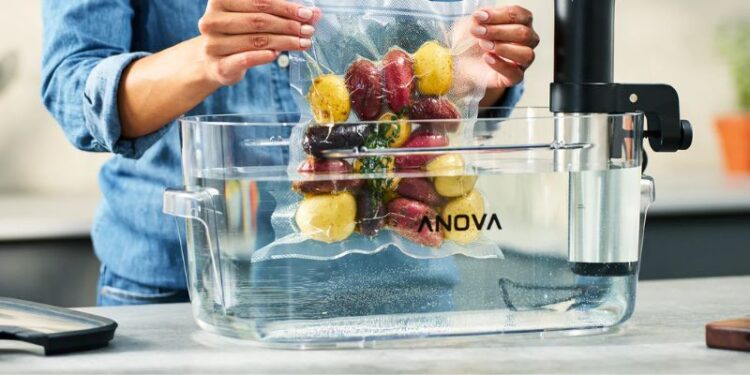Nowadays, professional chefs and food enthusiasts have become progressively intrigued by sous vide cooking. This article will explore “What is a Sous Vide Cooker and How Does It Work?”, the manner in which it works, its benefits, ways of using it, and that is just a glimpse of something larger.
What is a Sous Vide Cooker and How Does It Work?
Sous vide, which translates to “under vacuum” in French, is a cooking technique in which food is cooked in airtight bags in a water bath at precisely controlled temperatures. The sous vide cooker, generally called a submersion circulator, is a contraption used to achieve this precise temperature control.
How is it used to cook sous vide?
To create predictable and exact outcomes, the sous vide cooking technique requires exact temperature control.
How does it function?
- Water Shower: The sous vide cooker has a water-filled pot or container attached to it.Throughout the cooking process, the cooker heats and circulates the water to maintain a constant temperature.
- Temperature Management: On the sous vide cooker, the user selects the desired cooking temperature. The apparatus heats the water to that temperature and keeps it there.
- Sealed Bags: The food, along with any desired seasonings or marinades, is placed in a vacuum-sealed bag. The bag is then submerged in the water bath, allowing the food to cook evenly.
- Cooking Time: The cooking time for sous vide dishes can vary depending on the type and thickness of the food. However, sous vide cooking generally takes longer than traditional methods due to the lower cooking temperatures used.
Benefits of Using a Sous Vide Cooker
Sous vide cooking offers several advantages that make it a preferred method for many cooking enthusiasts and professionals:
- Flavor and Nutrient Retention: Since the food is cooked in a sealed bag, it retains its natural flavors, moisture, and nutrients that might otherwise be lost through traditional cooking methods.
- Consistency: Sous vide cooking provides consistent results, ensuring that food is cooked evenly from edge to edge. This eliminates the risk of overcooking or undercooking.
- Convenience and Versatility: Sous vide cookers are designed to be easy to use, allowing you to set the desired temperature and walk away. They also offer versatility in cooking various types of food, from meats and vegetables to desserts.
Choosing the Right Sous Vide Cooker
When selecting a sous vide cooker, consider the following factors:
- Type of Sous Vide Cooker: There are two main types of sous vide cookers: immersion circulators and water ovens. Immersion circulators are more common and affordable, while water ovens offer all-in-one solutions but tend to be pricier.
- Temperature Range and Precision: Look for a sous vide cooker that offers a wide temperature range and precise temperature control for optimal cooking flexibility.
- Power and Speed: Consider the power and speed of the cooker, as it can affect the time it takes to heat the water and bring it to the desired temperature.
Tips for Using a Sous Vide Cooker
To make the most out of your sous vide cooking experience, follow these tips:
- Food Preparation: Season the food before sealing it in the bag and remove any excess air to ensure proper cooking and flavor infusion.
- Sealing Techniques: Invest in a high-quality vacuum sealer or use the water displacement method to achieve a proper seal on the bags.
- Cooking Times and Temperatures: Refer to sous vide cooking charts or recipes for recommended cooking times and temperatures for different types of food. Adjustments can be made based on personal preferences.
Recipes and Culinary Applications
Sous vide cooking opens up a world of culinary possibilities. Here are a few examples of dishes that can be prepared using a sous vide cooker:
- Steak: Achieve a perfectly cooked steak with a tender and evenly cooked interior.
- Chicken Breast: Keep the chicken moist and tender by cooking it sous vide.
- Vegetables: Enhance the flavors and retain the nutrients of vegetables by cooking them sous vide.
Safety Considerations
To ensure food safety when using a sous vide cooker, keep the following guidelines in mind:
- Handling and Storing Cooked Food: Once cooked, promptly chill or consume the food to prevent the growth of harmful bacteria.
- Avoiding Cross-Contamination: Clean and sanitize all surfaces and utensils that come into contact with raw or cooked sous vide food to prevent cross-contamination.
Cleaning and Maintenance
Proper cleaning and maintenance of your sous vide cooker are essential for its longevity and performance:
- Cleaning: Follow the manufacturer’s instructions for cleaning the sous vide cooker, which typically involves wiping it down with a damp cloth and mild detergent.
- Storage: Ensure the cooker is completely dry before storing it in a clean and dry location to prevent the growth of mold or bacteria.
Sous Vide Cookers and Professional Kitchens
Sous vide cooking has made its mark in professional kitchens as well:
- Restaurants: Many renowned restaurants incorporate sous vide cooking to achieve consistent results and elevate their dishes’ flavors and textures.
- Benefits for Chefs: Sous vide cooking allows chefs to plan and prepare dishes in advance, reducing last-minute rush and enhancing efficiency.
Conclusion
Sous vide cookers have revolutionized the way we cook, offering precise temperature control, consistent results, and flavor retention. Whether you’re a culinary enthusiast or a professional chef, a sous vide cooker can elevate your cooking game and open up a world of creative possibilities.
Hope you like reading article on “What is a Sous Vide Cooker and How Does It Work?”!


online apotheke preisvergleich: gunstige medikamente direkt bestellen – medikamente rezeptfrei